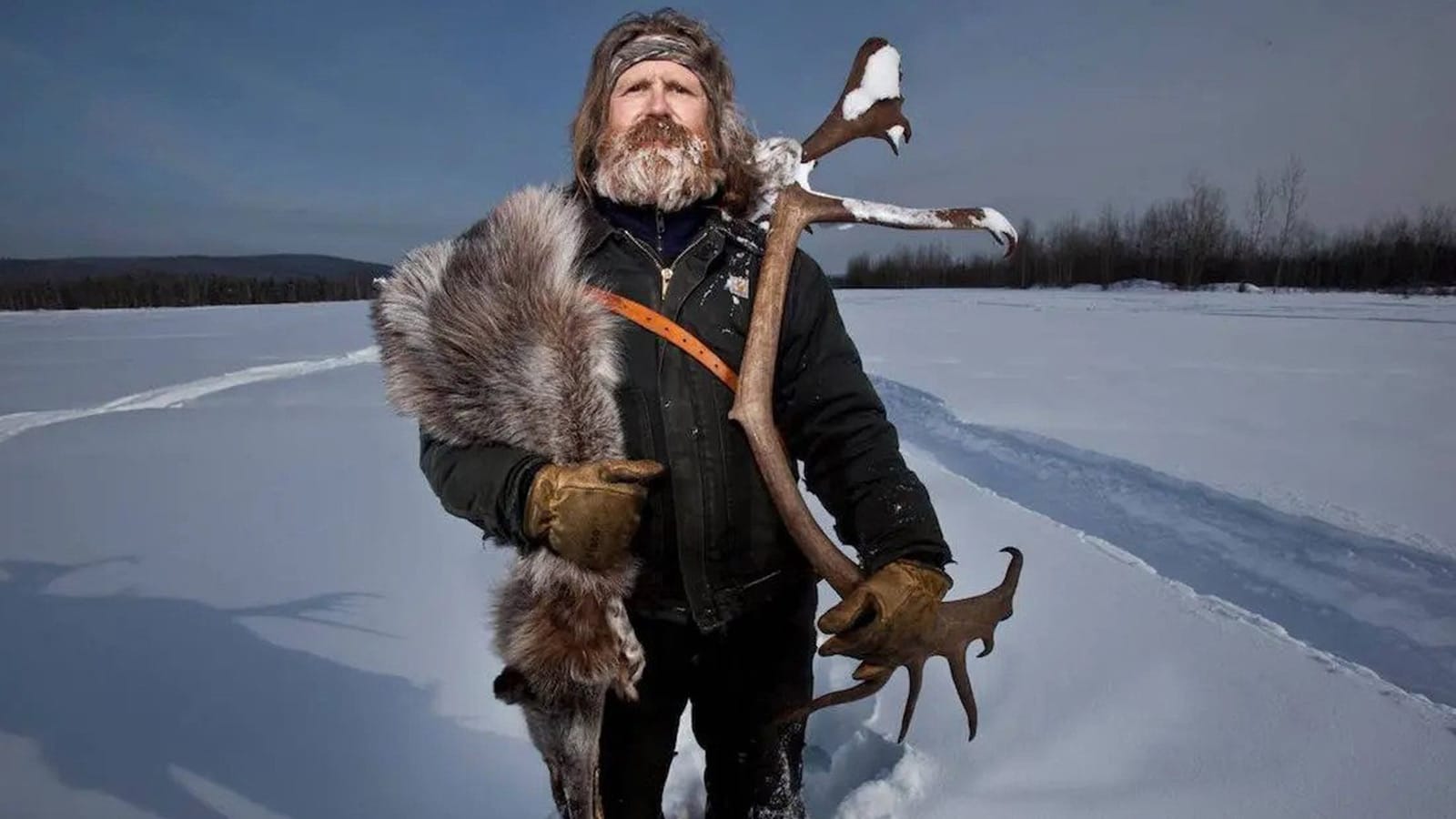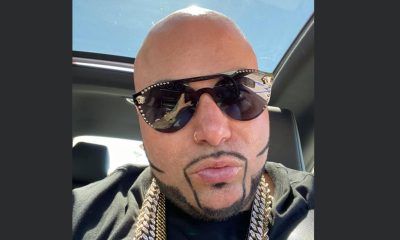Lists
What is Marty Meierotto from “Mountain Men” doing now? After Leaving The Show

Marty Meierotto’s life and adventures in the wilderness as shown in History Channel’s “Mountain Men”, earned him the admiration and perhaps even the envy of many who longed for such a lifestyle. The long-time Alaskan trapper and hunter had been in the show for eight seasons since it made its television debut in 2012. He was as authentic as they come, giving trappers a positive image, so it was understandable that his absence from the show was felt by many.
Contents
Get to know Marty Meierotto
Marty Meierotto was born on 19 July 1960, in Superior, Wisconsin, the second son of four children with the youngest as the only girl. He was six when the family moved to a rural community in Foxboro, 20 miles south of Superior. His father, Thomas, loved the outdoors and turned their 80-acres of land into what he called a ‘hobby farm’ with a few horses, chickens and a garden. He was a patient teacher who exposed Marty to the wonders of nature and the thrill of the hunt, instilling in his son the respect and love of wild places and all that inhabited them.
Marty said, ‘The one over-riding force that shaped my life was my love of trapping, and all things wild.’ He fell in love with hunting when he was a young boy, but it was trapping that set his heart on fire. It was on the small walking trapline for foxes and raccoons that he first realized the course that his life would take, because it was there that he came alive and felt that nothing could compare to that experience.
There might be a lot of distractions growing up, but one thing that remained constant for him was trapping. As he reached his 20s, his trapline, the route in which the traps were set, had become more extensive, encompassing a wider area, and involving a road system and a vehicle. Soon, this wasn’t enough for him, and he felt the call of the wilderness, a place that was more remote, and he believed that the real deal could only be found in Alaska.
He along with his brother Jeff eventually moved to Alaska in May 1985, first in Anchorage, but it was too much of a city for them, and so they went further until they reached Fairbanks. It was more to their liking so they settled in the area, found jobs, and later bought a trapline for sale on the remote Squirrel River. From what was left of their meager funds, they purchased what they thought they might need, and just planned on living off the land. He said that the thrill of the unknown, of what awaited them, and of the adventures that they would have was beyond description.
In 1987, the brothers chartered a plane to get to their new home. They were isolated with no way to contact those from the outside world, but for Marty, this was living his dream. He earned money by selling the furs or pelts of martens, lynxes, wolves and anything else that he caught in his trapline. To make ends meet, he had summer jobs, and was a commercial fisherman before he started working for the Alaska Fire Service in 1988 as a wildland firefighter. He was a “hot-shot” first until 1993 and then a smoke jumper for 21 years, before serving as their pilot in 2015.
His wife, Dominique
Marty was all praise for Dominique for her countless sacrifices just so he could pursue his passion in life, even if it meant being separated for months, saying, ‘How many women would stand for a kiss on the cheek in October and a promise that I might be back for Christmas?’ She had no way of knowing if he survived the arctic wilderness until his return. For most women, he wasn’t a good bet – he had no full-time job and was away during the holidays. It boggled his mind how and why she did it, and said that he was humbled by her faith in him.
Dominique was the first woman he brought with him to his happy place. He thought that since they had been dating long enough, it was time for her to see how bad his lifelong addiction to the bush lifestyle was, and what being with him really meant. She must have been so into him that even if she wasn’t used to roughing it, she stuck with him. He let her into his world and adapted to the changes she brought into his life. She spent her winters with him in the wilderness, at least until she gave birth to their daughter, Noah Jane.
Learned to fly a plane for Dominique
Getting sick in the bush was said to be life-threatening, especially if a first aid kit or over-the-counter medication was not enough to treat the condition, because there was no way for a person to ask for help from the outside world. Marty and Dominique landed on Squirrel River in mid-October, and the days passed by smoothly until about mid-November when Dominique fell ill, and was worried that it might be a bladder infection.
The responsibility of bringing her to the bush weighed heavily on him – ‘I had finally found that special person to be with, and I have taken her to this place and it was killing her. I was killing her.’ The plane was expected to return for them in the first week of December, and he feared it would be too late for her. He only had a handheld aircraft radio, but its range was line of sight. Dominique was getting worse each day, and despite his efforts to head to the hills whenever possible, he couldn’t contact anyone. Finally, an aircraft passed by and he was able to ask for help via the radio. Dominique was taken to the hospital on Thanksgiving Day. This ordeal made him realize that he needed to own a plane and learn how to fly it, especially if he would be bringing Dominique with him here. He bought one in 1994.
Came close to dying in the Bush
Marty was fully aware of the dangers that living in the bush entailed. However, it never occurred to him that he would come close to dying not by hypothermia or an encounter with a bear or other predators, but by pancreatitis. It began with a stomachache, and thinking that it was a case of food poisoning, he took medication to induce vomiting. However, the pain intensified to the point that he was screaming out loud. Despite the excruciating pain, he drove his snowmobile to ask for help from his friend Jay and his girlfriend who were staying at one of his trapline cabins, 15 miles from the main cabin, before he became incapacitated.
The couple did all they could to make him as comfortable as possible, and at the same time figure out how to get him to a hospital. As several days passed with no hope in sight, Marty asked his friend to write something for him – his last will and testament. He didn’t have much, but he wanted to give his girlfriend, Dominique, what he had. When they heard on the radio that Dominique and Marty’s brother Jeff were coming over, Jay and Amy created a big S.O.S. sign on the snow. Finally, when the plane taxied on the strip by the cabin, Marty knew he would make it. He was diagnosed with acute pancreatitis, bowel obstruction, and dehydration. He underwent surgery, and was released from hospital after 20 days, and 40lbs lighter – Dominique nursed him back to health.
Saved a reporter’s life and it led to his being cast in the show
Warm Springs Productions of Montana reached out to the Alaska Trappers Association, as they wanted to cast Marty Meierotto in a reality show for an accurate portrayal of a mountain man. This interest was brought on by a 12-page feature article on Marty written by Bill Heavey for “Field and Stream” magazine, which had a circulation of 1.5 million. It was about his life in the most remote part of Alaska, and running a trapline.
Marty ran a 120-mile trapline, and had one main cabin and four smaller ones situated at various points along the line, using a snowmobile to travel his line. He brought Bill along with him as he covered about 20 to 30 miles, and left the writer in a cabin to wait for him while he ran spur lines. On the third day, Bill could no longer keep up with Marty, and just wanted to get back to the main cabin, following a map drawn by the expert trapper, but took a wrong turn and got lost on a trail that was quite steep. After falling off his ride twice, the snow machine got stuck, and he was too exhausted to move it.
In the three hours that he was alone at 30 degrees below zero with only a small fire to keep him warm, he couldn’t help but think that he would be dead by the time Marty found him. Marty, who was more amused than alarmed by Bill’s situation, had said, ‘It wasn’t a life or death thing; I was going to find him regardless, but from his perspective it was.’
🌟Watch tonight @History 9pm Season 7 Finale #MountainMen @MountainMen "Hell or High Water" w/ #EustaceConway #MartyMeierotto #TomOar #MorganBeasley #JasonHawk #MargaretStern About: https://t.co/ydVS0ukroO pic.twitter.com/a3RVaYa6Zg
— TV Tango (@TVTango) November 1, 2018
Marty Meierotto in “Mountain Men”
The reality TV series featured mountain men, and Marty Meierotto was one of them. He was around 5ft 9ins, about 170cms with a medium-stocky build, shaggy red-gray hair usually corralled by a bandana, and sporting an unruly beard. He wore eyeglasses that others said made him look a bit on the goofy side. Marty lived in a small community in Two Rivers, about 23 miles or 40kms outside of Fairbanks. Come wintertime, he would fly his two-seater mono-plane to his cabin on the Alaska North Slope, as he made a living as a fur trapper.
As a precaution, he gave Dominique a rundown of his plans, so if she didn’t hear from him at a certain time, she would know that something was wrong, and had a good idea of where to send a search party for him. After he landed his plane, he had a 30-minute walk ahead of him to reach the cabin, and had his rifle ready in case he encountered wolves or bears. He checked on the cabin and the snowmobile before he chopped down dead trees for firewood, and hauled in fresh water from the Squirrel River. Next, he geared up to cover 150 miles to set up his trapline. He would later check on those traps to see if he caught anything, or if he had to reset them. After three months of running the trapline, he would bring the furs for auction.
Marty didn’t have a quit bone in his body. He taught himself everything he needed to know to survive the isolation and the wilderness in Alaska. When faced with obstacles, he found ways to overcome them. Upon realizing that his life depended on a snow machine, he learned not just to operate it, but also to fix it. He learned carpentry, welding, and electrical skills, and studied wildlife biology so he knew the best ways to catch them. Marty prepared for worst-case scenarios because he said that it would happen eventually – out there, one couldn’t afford to make a mistake or overestimate one’s abilities, because it was always a matter of survival as the cold made everything more difficult and dangerous.
Marty’s exit from the reality TV series
In season eight of “Mountain Men,” Marty said that it was time for his 13-year-old daughter to learn the family business hands-on. He would teach her all about trapping full-time, and surviving in the wilderness. It was important for him to show Noah this lifestyle; however, what she did with her life in the future would be totally up to her. She might not become a trapper, but at least she would better understand it and him.
https://www.instagram.com/p/CFtQFdslPcm/
He had been preparing to head out to his trapline with his daughter when he suddenly told someone from the production team that for Noah’s sake, he didn’t want cameras following them. He thought a lot about this before making this decision, and felt that this was best for Noah. Marty explained that he’d been doing this his whole life, and for the past eight years, he’d had cameras on him, but he wanted this experience to be just a special time between father and daughter. He figured that if he was lying on his deathbed, he wasn’t going to think about how much money he made, but what he’d done with his life.
His fans were saddened by this unexpected development, but at least they knew the reason why he opted to not be part of the show any longer. He was last seen in season eight’s “Final Farewell” episode – many wondered what happened to him after that.
Retired from the Alaska Fire Service
Marty retired from the Bureau of Land Management (BLM) Alaska Fire Service after 31 years, and flew his last mission on 30 July 2019. His family, friends, and co-workers had a surprise for him at the tarmac in Fairbanks. As he was taxiing on the runway after landing, he was given a water salute by two fire-fighting vehicles. He could only laugh, as he was embarrassed by all the attention he was receiving.
Published a collection of his stories
Some said that Marty could easily pass off as a bumpkin, but he was far from it. He’s a voracious reader and a good writer. Over the years, he submitted articles related to trapping and the outdoors to the Fur-Fish-Game and Alaska Trapper magazines. His book, “In the Land of Wilderness,” published in 2020, is a collection of stories of his adventures in the Alaskan Bush that previously appeared in those magazines. Marty credited his ‘book team’ from the Alaska Trappers Association for this project, with special mention of its president, Randy Zarnke, who could decipher what he called his rough ‘trapper speak’, and make it more intelligible to the readers. Randy said that his old friend had an engaging writing style, and had given a great insight into the world of trapping and hunting in the wilderness.
To live the life of a mountain man was never easy, and the work was never done. The price of fur has its ups and downs, and when it’s too low, many put their operations on hold to wait for better days, but not Marty; fur trapping was more than just a means to earn money for him. Regardless of the financial gain or loss, he carries on as this lifestyle is part of who he is, of the very fiber of his being. At times out of frustration he would say that it wasn’t worth it, but upon reflection, the experiences he had from the challenges, which tested the limits of what he could endure, to the unexpected thrills, still fired up his blood after years had passed.
Alaska is still his home, and when not in the wilderness, he lives with his wife and daughter in a log cabin they built in Two Rivers. His joys in life remain the same – his family, hunting and trapping.
Lists
What is Ricky Van Shelton up to today? What happened to him?

Ricky Van Shelton is a retired country music superstar, who spent three decades in the industry. He found early recognition and was successful and beloved by the audience only two years after he started working on his music. During his lengthy career, Ricky released nine studio albums, four compilation albums, and two holiday albums. His work was praiseworthy; 20 singles landed on the Billboard Hot Country Songs charts, 10 charted in the number one spot, and seven were in the top 10. Unfortunately, Ricky Van Shelton stopped recording around 2000, and announced his retirement in 2006. Here’s what happened and what he did afterwards.
Contents
- 1 Ricky didn’t cater to the mainstream sound
- 2 A demo launched his career
- 3 He persevered despite the genre’s decline
- 4 Ricky had trouble with alcohol in 1992
- 5 He voiced his displeasure
- 6 He recovered and adjusted his career goals
- 7 Ricky retired a decade and a half ago
- 8 He never returned to the scene
- 9 Ricky lives on his terms
- 10 He isn’t keeping his fans in the loop
Ricky didn’t cater to the mainstream sound
Ricky Van Shelton was a renowned recording and performing country music artist between 1986 and 1992 and could have kept going. His albums were certified platinum and gold by the Recording Industry Association of America (RIAA), and he had thousands of fans awaiting new releases. However, his displeasure with the new wave of country artists in the early 1990s, which would force him to alter his sound, put him off.
Ricky wanted to do what he loved, and didn’t regard his public fall from grace that way. He was always open about being lucky to find fame in his 30s, and his readiness to leave the industry when it no longer aligned with his goals. Thus, Ricky started a recording label, had a minor studio album release, then signed with another well-known label before he got tired of performing and touring. Ricky had earned enough to live off his past work and so dedicated his life to his hobbies, household duties, and marriage.
A demo launched his career
Ricky’s father was musically inclined, and son began singing gospel and pop music as a child. However, his love for country music developed in his teens, and he promptly joined his brother’s band and began performing wherever he could. Although he worked in area clubs, his name needed to be more recognizable to earn a living, forcing him to work various other jobs.
He finally got lucky after he moved to Nashville, Tennessee in 1984, which many consider the Mecca of country music, with his then-girlfriend, now wife, Bettye Witt. After two years of performing, newspaper columnist Jerry Thompson heard one of his demo tracks, and facilitated an audition with one of the oldest companies in the sound business, Columbia Records.
Jerry started managing his career after Columbia Records signed Ricky to CBS Records International, a branch of the main label that released recordings outside North America. His first album, “Wild-Eyed Dream,” released in 1987, was an instant success, and the singles after that charted better and better. His second album, “Loving Proof,” released in 1988, reached first place on the Billboard Council albums list, and had three top-charting singles.
He persevered despite the genre’s decline
Ricky Van Shelton enjoyed praise and high chart positions until 1992. That wasn’t his fault entirely. His albums, “RVS III” from 1990 and “Backroads” from 1991, still charted well. However, the popularity of his country music sub-genre, neo-traditionalism, was waning. Therefore, his colleagues such as Dwight Yoakam, George Strait, Garth Brooks, and Randy Travis also faced troubles.
Grand Ole Opry, which he joined in 1988, described the change as the appearance of ‘a group of hat acts,’ cowboys who moved away from the traditional country genre to release music with pop, gospel, and rock influences. Moreover, female country stars rose in prominence; Shania Twain, Martina McBride and Faith Hill figuratively stole a portion of the audience.
Ricky had trouble with alcohol in 1992
As if the industry decline wasn’t affecting his career enough, Ricky finally confessed that he’d struggled with alcoholism for a while and wanted to become sober. His fans knew that he was serious and that it could mean giving up his career if sobriety was more important. After all, Ricky told Detroit Free Press in 1990, ‘I’ve always had faith in myself… With these three albums, it’s been wonderful. However, if it ends tomorrow, I would just walk away with a smile.’
His admission brought attention to his life away from the spotlight – people around him revealed that alcohol had taken full control of his life. Ricky staved off his alcoholism on stage to avoid ruining his career but struggled away from the spotlight. Consequently, his drinking destroyed his relationship with family and friends, and his eight-year-long marriage was in danger. His parents didn’t want to meddle in his affairs, but ended every conversation with, ‘We’re praying for you, son!’
That forced Ricky to self-reflect, and recalled how happy his childhood was. Since he sang gospel in church growing up, and his type of country music was losing popularity, he switched things up and in 1992 released an album of his favorite gospel songs, “Don’t Overlook Salvation,”
Ricky Van Shelton became a member of the Opry 33 years ago today!
What's your favorite song of his? pic.twitter.com/MS3PwjkiUN
— Grand Ole Opry (@opry) June 10, 2021
He voiced his displeasure
Ricky’s departure from mainstream music wasn’t so hasty. Some fans recalled his interview with Morning Call in November 1999, when Ricky revealed that his dissatisfaction with the music industry began in 1992, when he performed at the Country Music Association’s anniversary event. He stated that the songs he was supposed to sing weren’t in his key, however, the event’s director told him and other participants that it didn’t matter what they sounded like, only that the performances looked good on camera. Ricky was insulted, saying he would leave instead of sounding bad because of someone else’s decisions.
Shortly after security escorted him from the event for refusing to co-operate, Ricky also started disliking his radio performances. He stated that the new wave would ruin the country because the artists sounded alike. What hurt him the most was that the single, “Where Was I,” from his platinum-certified 1991 studio album, “Backroads,” vanished from all charts after his statements, despite being ‘hot as a firecracker,’ according to him.
He recovered and adjusted his career goals
Although he never clarified whether he beat his alcohol addiction, Ricky noted that his career rapidly deteriorated because he didn’t want to conform to current trends. Thus, Ricky left Columbia Records after releasing two more studio albums, “A Bridge I Didn’t Burn” in 1993, and “Love and Honor” in 1994. However, his former label released several Greatest Hits collections afterwards, including “Super Hits” in 1995, “Super Hits Vol. 2” in 1996, and “16 Biggest Hits” in 1999.
Ricky decided to reduce his touring and recording commitments in 1997, and launched the recording label, RVS Records. He financed his next album, “Making Plans,” and released it solely in Wal-Mart stores the following year.
His eighth studio album received some praise, but lacked the backing of a large record label. Plus, its release made it unable to chart, and he didn’t release any singles. As a last-ditch effort to revive his career, Ricky signed with the Canadian record label Audium before releasing his last studio album, “Fried Green Tomatoes,” in May 2000. Although it had a notable single, “The Decision,” it didn’t achieve noteworthy worldwide success.
Ricky retired a decade and a half ago
Ricky continued touring and performing his best-known songs for six years through 2006, however, everyone noticed his reluctance to live a country superstar life. He was never really into fans camping in his trailer or throwing him objects such as teddy bears and lingerie, some of which had female fans’ numbers and names. Additionally, Ricky never lived a fast-paced rockstar life, which included sleeping around, taking drugs, or partying late into the night. Most importantly, his fans noticed that he barely gave interviews after 2000, which suggested that the end was near.
Most of his fans were unsurprised to read Ricky’s letter, dated 3 May 2006, informing everyone that he would take a break. He asked the label to release him from performing for the rest of the year, saying that he wanted to spend more time with his family. However, when the hiatus stretched into 2007, and he didn’t return the year after, it was clear that Ricky had decided to retire, at least until further notice.
He never returned to the scene
Ricky never clarified why he retired, as many assumed that he loved country music and performing. However, he never wanted the headache, busy lifestyle, and constant competition that being a recording artist demands. Many fans need to remember that Ricky struggled to find recognition until he was in his mid-30s and only enjoyed several years of unbelievable success before his fame took a toll.
Following several decently-performing albums after 1992, Ricky presumably recognized that he would never recapture the stardom that he once had. Thus, he potentially decided that the sacrifices of being away from family and friends weren’t worth the moderate success he could maintain.
Although he refused to speak publicly about his reasons or potential plans for his return, his website, www.rickyvanshelton.com, provided some information – Ricky used his retirement years to work on his 150-acre farm, located along the Cumberland River, east of Nashville. He was also interested in collecting antiques, including expanding his classic car collection, gardening, and flying his airplane.
https://www.instagram.com/p/CR6sYBmhlQA/
Ricky lives on his terms
After becoming an instant star in the late 1980s, Ricky Van Shelton was a sensation for roughly eight years. At the height of his fame, he decided not to blend in with the so-called New Country wave, explaining that he refused to look or sound like other country stars. Ricky’s unwillingness to align with the record label’s plans and standards led him to leave fame behind, and make independent decisions.
True fans appreciated the post-1992 releases. After Ricky launched his label, many fans rushed to Wal-Mart to hear what he had to offer, and still showed up at his shows until 2006. His passion for performing wilted, and he couldn’t justify the financial, time, and energy investments. Hence, Ricky quit media life and now enjoys privacy, having been one of the best-recognized male country music vocalists.
He isn’t keeping his fans in the loop
Although fans can read or hear some old interviews, only bits of information are available. Ricky’s official website, created in June 1997, is inaccessible despite its renewal in 2018. Similarly, his official Facebook page under the handle @rickyvanshelton.music, has been deleted. Only his fans keep the legacy alive online. A Facebook fan group, Bring Back Ricky van Shelton, mentions occasional tidbits that surface online. For example, they keep track of his wife’s YouTube channel, @@BettyeShelton-RickyVanShelton, and noticed that she’d uploaded an unreleased song that Ricky wrote, “I Know About You and Me,” on 14 May 2022. She recorded it with her iPhone’s Voice Memo app; fewer than five people had heard it before that day.
That shows that Ricky is still happily married to the woman he began dating in 1979, and tied the knot with seven years later. Bettye is equally satisfied with her life; she released a 25-second video of Ricky’s contagious laughter in August 2020, a video of them celebrating Easter morning that year, and landscaping their yard. She also revealed that her husband still loves Randy Travis. Bettye posted a video of Ricky saluting and admiring Randy in the home studio in 2017 for being ‘distinctive and a true star.’ Her uploads indirectly disproved fake news on YouTube in 2022, about Ricky ‘being in critical condition and begging for help’.
Lists
What happened to Miranda Lambert? Why did she quit music?

Fans are still reeling after hearing that Miranda Lambert, a well-known country music star, is quitting her music career after two decades in the industry. She announced her decision in March 2023, which was surprising because she released her last studio album almost exactly a year before. Therefore, nothing indicated that Miranda would stop doing what she (apparently) loved, including touring and performing at sold-out venues. Here’s why she decided to end her career, and what she plans to do instead.
Contents
- 1 She was extremely successful
- 2 Miranda loved music from a young age
- 3 A talent competition brought her fame
- 4 Blake Shelton skyrocketed her popularity
- 5 2017 was one of her best years
- 6 Something changed during the pandemic
- 7 She recently tweaked her music
- 8 She had vocal issues
- 9 Miranda may expand her family
- 10 Miranda wants to help animals
- 11 She is working on her brand
- 12 Miranda didn’t quit music
She was extremely successful
Many entertainers, actors, musicians, and singers retire from their profession once the opportunities dry up, and new faces take over the industry or even the genre. Miranda’s case is different; she had moderate to outstanding success for 20 years and has won three Grammy Awards. Additionally, her most recent studio album received universal critical acclaim with a score of 83 out of 10 on Metacritic and a Country Music Association Award for Album of the Year nomination.
Moreover, she had five high-charting songs and 10 number-one singles in her career. Thus, her decision to leave Sony Music Nashville on 15 March 2023 didn’t make sense. However, Miranda’s priorities recently shifted behind the scenes, and she wanted more time for her family, personal brand, and entrepreneurship.
Miranda loved music from a young age
Miranda Leigh Lambert, born on 10 November 1983 in Longview, Texas, USA, and raised in the town of Lindal about 50 miles (80kms) away. Her father inspired her love for music when he played his guitar, and her music taste eventually ranged from mainstream to outlaw country from the 1970s and 1980s.
She decided to showcase her talent at 16, started writing music, playing guitar, and performing at talent shows and honky-tonk bars. Moreover, her music had a distinct theme. Her parents, Rick and Bev, who worked as private investigators, lost all their money in the oil crisis in the 1980s and 1990s. They became ministers for a Methodist church and brought endangered or abused women home for protection, and their stories around the kitchen table inspired Miranda’s lyrics. After she realized her potential and received support from the audience and people close to her, Miranda ensured that she would matriculate from high school early. That allowed her to release a self-titled and produced “Miranda Lambert” album in 2001.
A talent competition brought her fame
Her first album received little attention, hence Miranda decided to front a larger audience and talent scouts, by competing in the TV talent competition “Nashville Star” two years after her album’s release. She failed to secure the top prize, but an Epic Nashville executive and on-air judge, Tracy Gershon, noticed her, signed her to the label in 2004, and Miranda began recording her next album.
On 15 March 2005, she released her debut studio album, “Kerosine.” Four of its songs entered the top 40 of the Billboard Country Singles chart, and the title track reached 15th spot. It was a perfect mix of outlaw country with what critics described as ‘a love gone wrong theme,’ folk-pop influences of classic country, honky-tonk, and country rock. Her next album, “Crazy Ex-Girlfriend,” released in 2007, was even snappier and louder, because she wrote nearly all 11 tracks, and what sparked interest was Miranda’s authenticity; journalists revealed that she wrote those songs, including her highest charting single, “Gunpowder & Lead,” while having a concealed carry permit, and taking her handgun wherever she went.
Blake Shelton skyrocketed her popularity
Miranda’s popularity increased considerably after she released her 2009 album, “Revolution,” which contained her first number-one single on the Billboard Country chart, entitled “The House That Built Me”, and received a Grammy Award for Best Female Country Vocal Performance for that song in February 2011.
Despite her solo success, Miranda’s romantic life put her and her work in front of a massive audience – she began dating a country singer Blake Shelton in 2006, but most people only found that out when he co-wrote some songs on her 2009 album, or even later when they married in 2011. Additionally, Miranda and her girl music group, “The Pistol Annies,” were heard on Blake’s 2012 Christmas album, “Cheers, It’s Christmas,” and his well-known 2013 single, “Boys’ Round Here,” which eventually reached the top position on Billboard’s US Country Airplay chart. It was ultimately a five-times platinum-certified single in the US by the Recording Industry Association of America (RIAA).
2017 was one of her best years
Miranda’s prominence grew despite her broken heart; she divorced Blake in July 2015, and within the year he moved on with his now wife, singer Gwen Stefani. Her two albums, “Platinum,” released in 2014, and “The Weight of These Wings” from 2016, were well received. Moreover, she broke some records by winning her eighth successive Academy of Country Music Award for Female Vocalist of the Year, and her seventh CMA (Country Music Association) award in the same category.
Something changed during the pandemic
After announcing her seventh studio album, “Wildcard,” and releasing it in November 2019, Miranda wanted to go on a 27-city tour across North America. However, the outbreak of the COVID-19 pandemic hindered some planned performances, and the tour concluded in Canada in May 2020. A slight change was evident on the album; for instance, it was her first time working with another producer, and Jay Joyce helped make the album what it was. Also, it was her first country rock album in a while; the fifth studio album was marketed as a classic country, and the sixth was categorized as alternative country.
Additionally, Miranda would spend much more time at home. Her loyal fans know that Miranda bought a 400-acre farm near Primm Springs, Tennessee, an hour’s drive from Nashville, for $3,4 million in 2016. Moreover, she had a new man in her life; on 26 January 2019, she married Brendan McLoughlin, a New York Police Department officer. Many don’t know that Brendan had just had a son with his ex-girlfriend Kaihla Rettinger, when hey met Miranda in 2018. Therefore, Miranda, who said in 2015 that she wasn’t ready to raise kids, became a devoted stepmom to Landon from the get-go, and loved every moment. She even purchased a home in New York City to see him more often, since the newborn lived with Kaihla full-time.
Inspiration behind @idyllwind: Strength. Kindness. Sensitivity. Beauty. Fire. Power. Happiness.
Follow @Idyllwind to join the tribe. pic.twitter.com/HIf0C9u1je
— Miranda Lambert (@mirandalambert) February 27, 2019
She recently tweaked her music
Although “Wildcard” won the Grammy for Best Country Album in 2021, Miranda was already set on tweaking her sound. Her collaborative album that year, “The Marfa Tapes,” produced with Jon Randall and Jack Ingram, had a low fidelity, alternative music vibe. Moreover, she collaborated with Elle King, a country, blues and rock singer, on the “Drunk (And I Don’t Wanna Go Home)” single, and released a song to support the LGBTQ community, entitled “Y’all Means All”, on 30 December 2021.
She also released a folk, world, country and Christmas holiday album, “Hell of a Holiday,” two months before, in October, with her girl group, “The Pistol Annies.”
With that in mind, her last studio album under Sony Music Group, “Palomino,” released on 29 April 2022, didn’t fit the pattern; it demonstrated her return to her roots, and had a typical outlaw/cowboy country sound. However, many people need to realize that Miranda wrote all the songs in 2020 while on her Tennessee ranch and only re-recorded some for the album. Thus, the project was likely halfway ready before she started getting cold feet about being signed to a mainstream record label.
She had vocal issues
Some fans rushed to a conclusion on 31 March 2023, when Miranda canceled her Las Vegas concert at the Bakkt Theater, only two weeks after she announced becoming a free agent as a recording artist. She stated that she’d been under doctor’s care the entire day before, but that her physician ordered two days of vocal rest. Thus, while most followers showed their support, some suspected that Miranda had undisclosed vocal issues that forced her to part ways with Sony Music Group. Luckily, Miranda proved that it was a temporary setback, and performed without a hitch a few days later.
Miranda may expand her family
Miranda and her husband Brendan, have been open about their love for each other and their animals over the years. Additionally, after she gushed about her love for Brendan’s son, an insider revealed to Us Weekly in February 2022 that the couple started trying to conceive after their third wedding anniversary the month before. According to the source, Miranda felt emotionally ready, had enough practice with Landon, and Brendan always wanted to have biological children with her.
Additionally, the journalist revealed that she was building a house to accommodate their family in or around Nashville, which may or may not be on her 400-acre property. Therefore, Miranda likely wanted to pause her relentless pursuit of being a country music star, spend time with her husband, and work on growing their family.
Miranda wants to help animals
Judging by the interviews after March 2023, Miranda is stepping away from releasing albums to make time for her other passions. She has the charity MuttNation Foundation, which she started with her mother in 2009, with its goal to raise money for rescuing animals, animal shelters, and the high costs of veterinarian bills. She has an animal shelter on a ranch in Blake Shelton’s hometown, Tishomingo, Oklahoma, and has been vocal about the cause. Miranda also partnered with Tractor Supply Company and Greater Good Charities to sell pet products or provide pet meals for free. Most recently, on 20 April 2023, MuttNation and Tractor Supply Company announced that they had gathered almost $300,000 in donations from portions of pet product purchases.
She is working on her brand
Miranda has been the face of many products, including Cotton Inc.’s clothes, DSW’s line of shoes and boots, and Ram trucks manufactured by Chrysler, one of which, a 1500 Laramie Longhorn, she sold at an auction and donated the proceeds to MuttNation Foundation. Plus, she owns The Pink Pistol boutique in Lindale, has created a wine brand with Red 55 Winery, launched the clothing line Idyllwind, and has a line of home necessities and decorations, Wanda June Home, exclusively sold at Walmart.
Also, Miranda has always been a food lover, but her career kept her from seeking noteworthy success in the industry. That changed on 25 May 2021, when she opened a four-story, 17,400 sqft or 1,615m2 bar, entitled Casa Rosa or “pink house” in Spanish. Then, two years later, she published a cookbook entitled “Y’all Eat Yet?: Welcome to the Pretty B*tchin’ Kitchen” on 25 April 2023 with her co-author, Holly Gleason. It features her favorite recipes local to Texas and her mother and grandmother, who taught her to cook. She promptly embarked on a press tour to promote its release, and her break from music allowed her to do so.
Miranda didn’t quit music
Miranda has been at the top of her game since she signed a recording deal with Sony at age 19. After 20 years of consistent effort at concerts and during long days on tour and in the studio, which resulted in nine universally praised studio albums, she decided to take some pressure off. She’s now dedicated to her family, primarily her parents, husband Brendan, and stepson Landon, who turned 4 in 2023. Moreover, she’s following her passions in the food industry, and developing a personal brand by launching and advertising products from established brands.
https://www.instagram.com/p/Cs4AUUcuNMi/
However, her fans can be sure that Miranda will not quit music. She said in April 2023, ‘I am, for the first time in 20 years, a free agent. I don’t have a label and feel great about it.’ She added that she ‘feels inspired to be able to see the options out there because it’s a different landscape compared to signing her first record deal.’ She wants to be a part of a new wave of whatever is going on in her genre. Fans must remember that she launched a record label, Vanner Records, in 2016.
Moreover, Miranda announced a new song with Dierks Bentley on 5 May 2023, available on the soundtrack for the CBS TV show “Fire Country.” Most recently, she co-wrote some of 13 tracks on Jelly Rolls’ “Whitsitt Chapel” country album, scheduled for release on 2 June 2023.
Lists
How is Rent-A-Grandma doing after ‘Shark Tank?’

“Shark Tank” follows four to five investors, some of whom return season after season, looking for the right business to support financially. Unless the business has a ground-breaking idea, they rarely help it get off the ground. In most cases, the investors require a good track record; thus, their money allows the business owner to stay afloat, fulfill an existing order, expand to a new area, or finance research & development (R&D). Contestants have a few minutes to present their company and convince them without being dishonest. An on-screen handshake is not legally binding, and many deals fall through behind the scenes once lawyers, accountants, and sometimes Federal Trade Commission (FTC) get involved.
Revolutionary businesses are rare and usually reserved for Silicon Valley. Thus, most of the show’s success stories involved passionate entrepreneurs who improved an established product or service. Rent-A-Grandma falls into that category; Todd Colby Pliss, the founder, realized that a specific demographic, seniors, would be an ideal service provider for his business. He wanted to hire grandmothers as inexpensive caretakers, a role that was usually given to teenagers, students, neighbors, or temporary migrants. Unfortunately, when he presented the business opportunity, the “sharks” refused to bite, and he left without an investment.
However, his business didn’t suffer; the show’s popularity got people invested after the episode aired. Thus, Todd found new clients and, judging by his website, has a lot more than the initial 50 grandmothers in his employ. Here’s what happened to Rent-A-Grandma during and after “Shark Tank.”
Contents
The initial disinterest didn’t dissuade Todd
Todd didn’t get any money from the “Shark Tank” hosts when he debuted in the eighth episode of the third season. However, they praised his business acumen and celebrated his desire to involve an under-appreciated part of the population. After all, the community often neglects senior citizens, and Todd wanted to hire them to care for babies, children, and young teens. He felt that grandmothers would be better at nurturing without charging exorbitant fees, and that everyone involved would benefit. That would get him government support, too; some countries consider older people redundant if they cannot work.
Importantly, Rent-A-Grandma didn’t have to spend money on training; grandmothers could earn money from the job that they’ve done or still do for their loved ones. Additionally, the on-call and contractor nature of Todd’s business model allowed them to be available only when they felt capable. That benefited grandmothers more than financially; they found companionship, made friends on the job, and could take breaks.
Unfortunately, while they loved the business, it wasn’t far enough along, so the investors couldn’t make enough money in a reasonable period. Still, Todd didn’t lose heart, and restructured Rent-A-Grandma after 2012; the company is active and has expanded to include the other half of the older population, grandfathers.
The investors found his business model unsuitable
Todd gave an excellent presentation and even brought a grandmother to demonstrate the concept. He stated that he got the idea during his tutoring job, when he noticed a shortage of reliable childcare providers. His clients’ parents consistently complained about having to hire untrustworthy people unless they wanted to pay top dollar. While neighbors’ children or students were cheaper, they were often unavailable, inexperienced, overly accommodating, or distracted while on the clock.
In contrast, grandmothers had decades of parenting experience, lots of free time, and reasonable compensation demands. Todd drove the point home, saying, ‘Why hire a teenage nanny when you can have a grandma?’ Sadly, the “sharks” didn’t see enough current value to pay $150,000 for 20% of Rent-A-Grandma. Their biggest worry was Todd’s plan to focus on franchising, i.e., allowing others to start a business under Rent-A-Grandma’s name and business model for a fee. While that would let Todd’s company expand across the US, it could also weaken the profits.
Even worse, Robert Herjavec inquired about the grandmothers’ hourly wages, which were between $14 and $20. That was still serious cash since the minimum wage in Los Angeles, California, was $8 an hour between 2008 and 2014. However, franchising the business meant that the “sharks” would wait longer for a return on their money and start raking in cash, without hundreds of thousands of clients and contractors. Most importantly, owning one-fifth or one-fourth of the company meant that they wouldn’t have a decision-making percentage in the business. Therefore, the investors would, at best, be on the board of directors, and without veto power against what they considered poor decisions.
Kevin considered investing
Some of this TV show’s investors are willing to part with their money if they receive a nearly fail-safe deal. Kevin O’Leary and Mark Cuban saw potential in the business and asked the most questions after Robert, Barbara Corcoran, and Daymond John pulled out of investing. Mark eventually dropped out, wanting to avoid his name being attached to a business focused on seniors. Kevin was inquiring about the business model and the relatively low sales of only $25,000 the previous year. He liked that grandmothers sign a 90-day deal, reducing the inconvenience when one gets sick or, unfortunately, passes away.
After hearing the response, Kevin seemed to mull it over and was coming up with a “Mr. Wonderful deal” that he gives to desperate business owners. That usually indicated that he would want a 50%, if not 51%, i.e., the controlling share of the company, frequently without paying more than the asking price. He is also known to give money loans with incredibly high-interest rates, or request a percentage of the royalties to accelerate his money return. Unfortunately, Kevin couldn’t come up with a proposal that he was comfortable with, and Todd left the “Shark Tank” studio without money in his pocket.
Todd shifted his business priorities
Todd listened to the advice and rarely mentioned franchising after 2012. Instead, he doubled down on his original business model with a twist, and to signify this change, he renamed his business from Rent-A-Grandma to Rent A Grandma. His approach changed because he realized that he was thinking too small. Instead of looking for grandmothers in the Los Angeles area, then signing them up for a three-month-long contract, Todd was inspired by websites such as Craigslist.com and Angie’s List, now known as Angi. Therefore, he hired a web developer, Nicholas “Nick” Howe, at nicholashowe.com, to build him a WordPress website at www.rentagrandma.com.
Using a website solved two primary problems. First, Todd could now refer grandmothers to his website and get them to sign up for a carer account instead of handling their details himself. Second, his content management system (CMS) made it easy for grandmothers to see client requests and bid on jobs. In contrast, clients could see and book grandmother’s profiles online without contacting Todd. Most importantly, the advanced search by country and postal code meant that people across the globe could use his service.
Some previous investigations into the business suggest that he got rid of charging grandmothers 15% of every job in favor of a one-time $25 flat service fee. That was an excellent solution for a global business; taking a cut from local transactions would be a tax-filing nightmare. Handling conversion rates and payment processing would be a challenge, too. Additionally, if things were too complicated or expensive, people outside the country could report that their search was unsuccessful, then pay a grandmother outside the platform.
Rent A Grandma expanded its focus
After participating in “Shark Tank,” Todd realized his caregiving idea was too niche. Therefore, he increased the area of expertise; people could hire a tutor, a nanny, a chef, or a pet sitter. Moreover, they may require a grandmother for companionship, as a personal assistant, party attendee, or caregiver to a fellow elder or a special needs child.
Similarly, Todd decided to bring attention to grandmothers’ skills and patience. Therefore, he started a Merchandise page, where the business sells t-shirts with their logo and those with a “Grandmas Matter!” print. Moreover, he sourced products such as chocolate chip cookies, brownies, and oatmeal raisin cookies. That helped grandmas whose baking skills exceeded their caregiving ability to make some money. Additionally, some people never tasted their grandma’s cuisine, allowing them to fulfill their lifelong dream.
Happy 4th to all! pic.twitter.com/sMZMMDAuiL
— The Grandma (@rentagrandmacom) July 4, 2019
People can request grandmothers on mobile devices
While the website is mobile-friendly, Rent A Grandma took things further by releasing an eponymous iOS application on the Apple App Store distribution platform. However, the application is unavailable in 2023, likely because it did not receive an iOS 16 update or the code had problems. Additionally, Todd created two social media profiles, on Twitter and Facebook, under the handle @rentagrandmacom, and still uses a business e-mail, [email protected], for non-tech-savvy users, including grandmothers.
Rent A Grandma has a sister company
Todd realized that other adjustments would allow him to extend his reach without developing brand-new technology or reinventing the wheel. Therefore, he started a second company, Rent a Grandpa, with an accompanying website, rentagrandpa.com. Although it has the same tagline, with ‘grandpa’ replacing ‘grandma,’ it offers activities that men do more often. Therefore, clients can request various handyman services such as dealing with furniture, electricity, painting, and lawn mowing. Moreover, they can hire grandfathers who are automotive specialists, which is useful whenever a mechanic’s help is unnecessary or pricey.
Rent a Grandpa, a new company with a rising list of services, lacks pages such as FAQ (Frequently Asked Questions), Merchandise, and About Us. However, it added a star-based rating system for registered grandpas and did not charge grandfathers fees. However, it likely takes a percentage from their wages, as Rent-a-Grandma did, and is thus limited to US territory.
Todd did not need the “sharks”
While Todd thought pumping cash into his business early on would solve all his problems, the advice he received on set was valid. He needed more time to iron out all the kinks in his business plan, primarily restricting the company to the US and not using a website and a mobile app to streamline hiring, paying, and reviewing grandmothers.
Todd accepted criticism and examined his competitors, then applied excellent ideas, such as making Rent a Grandma available globally, on mobile and desktop devices, and via the website, social media, and e-mail. After boosting the number of services, including letting grandmothers sell baked goods, he included grandfathers through his second company, Rent a Grandpa. That showed his business acumen; hence both companies are growing. Unfortunately, Todd may be stretched too thin; both websites need an SSL certificate, which boosts their security and instills trust, and the promoted Phone application is inaccessible. While those oversights hurt his brand’s reputation, they are relatively inexpensive and easy to fix, which will no doubt happen soon!
-

 Instagram Stars3 months ago
Instagram Stars3 months agoKatelyn Runck – Measurements, Height, Age. Plastic Surgery?
-

 Twitch Stars1 month ago
Twitch Stars1 month agoThe Sphere Hunter’s Biography: Trans? Age, Face, Real Name
-

 Instagram Stars1 month ago
Instagram Stars1 month agoThe naked truth of Claire Abbott’s disappearance: Where is she now?
-

 Actors6 months ago
Actors6 months agoWho is Dylan Llewellyn? Age, Height, Gay? – Biography
-

 Youtube Stars4 months ago
Youtube Stars4 months agoHow Rich is Judge Frank Caprio? Net Worth, Salary, Family, Bio
-

 Web Stars2 days ago
Web Stars2 days agoWho actually is Hard Rock Nick? Net Worth, Real Name – Wiki
-

 Instagram Stars2 months ago
Instagram Stars2 months agoKara Del Toro – Age, Height, Measurements, Husband, Wiki
-

 Businesspersons1 month ago
Businesspersons1 month agoThe Untold Truth Of Brandi Love’s Husband – Chris Potoski












































